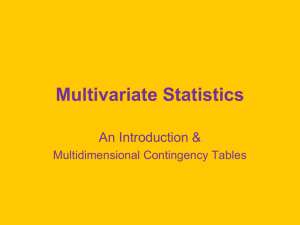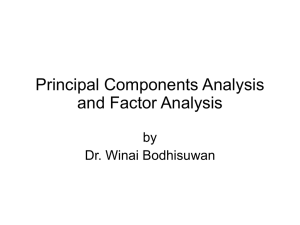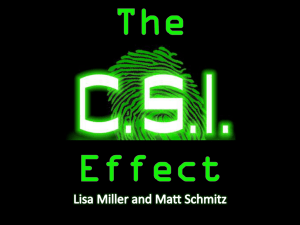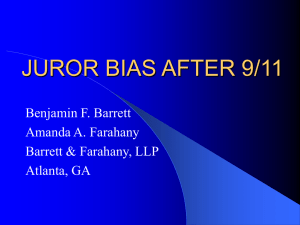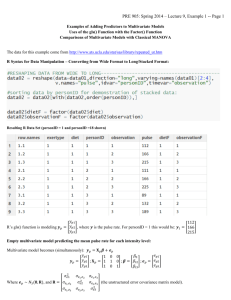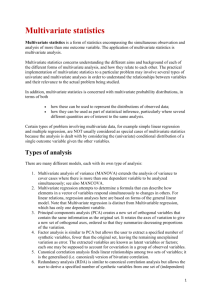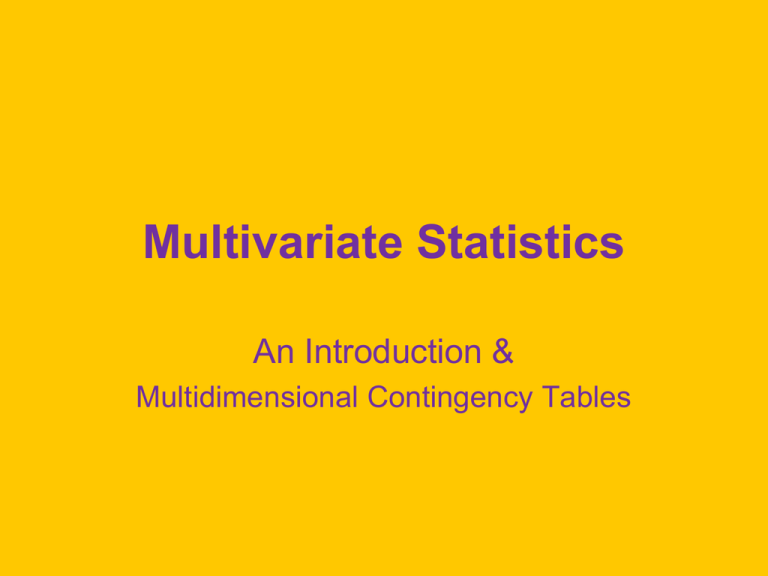
Multivariate Statistics
An Introduction &
Multidimensional Contingency Tables
What Are Multivariate Stats?
• Univariate = one variable (mean)
• Bivariate = two variables (Pearson r)
• Multivariate = three or more variables
simultaneously analyzed
One-Way ANOVA
• Could consider bivariate – one grouping
variable, one continuous variable.
• Could consider multivariate – predict Y
from the set of k-1 dichotomous dummy
variables coding the grouping variable.
Factorial ANOVA
• I consider it multivariate – one continuous
variable and two or more grouping
variables.
• Some call it univariate, as in “univariate
ANOVA.” Here the focus is on how many
comparison variables there are (only one
Y).
• If there were more than one Y, they would
call it MANOVA and consider it
multivariate.
Independent and Dependent
Variables
• Data analyzed with multivariate techniques are
most often nonexperimental.
• You know how I feel about using the terms
“independent variable” and “dependent variable”
in that case.
• But others use these terms more loosely.
• Independent = grouping, prior, known, thought to
be the cause.
• Dependent = continuous, later, predicted,
thought to be the effect.
Descriptive vs. Inferential
• Like univariate and bivariate stats,
multivariate stats can be used
descriptively.
• In this case, there are no assumptions.
• If you use 2, t, or F, then there are
assumptions.
Rank Data/Scale of Measurement
• Only God knows if your data are interval
rather than merely ordinal, and she is not
saying.
• Ordinal data may be normally distributed.
• Interval data may not be normally
distributed.
• Ranks are not normally distributed, but
may be close enough to normal.
Why Use Multivariate Stats?
•
•
•
•
To impress your friends.
To obfuscate.
Because SPSS makes it so easy to do.
To statistically hold constant the effects of
confounding variables in nonexperimental
research.
Why NOT use Multivariate Stats?
• You may be able adequately to address
your research question with more simple
analysis.
• One may be able to get pretty much any
damn results she wishes, so why bother?
• Do you really understand what is going on
out there in hyperspace? I am already
confused enough in three dimensional
space.
Multidimensional Contingency
Table Analysis
• Chapter 17 in Howell.
• Have three or more dimensions in the
contingency table. All variables are
categorical.
• Moore, Wuensch, Hedges, & Castellow
(1994)
• Simulated civil case, sexual harassment.
• Female plaintiff, male defendant.
The Design
• Physical attractiveness (PA) of defendant,
manipulated.
• Social desirability (SD) of defendant,
manipulated.
• Sex/gender of mock juror.
• Verdict recommended by juror
(dependent).
• Experiment 2: manipulated PA and SD of
litigant.
Logit Analysis
• This is a special case.
• One variable is identified as dependent.
• We are interested only in effects that
involve the dependent variable.
Earlier Research
• Physically attractive litigants are better
treated by the jurors. No Social
Desirability manipulation.
• But jurors rated the physically attractive
litigants as more socially desirable
(intelligent, sincere, and so on).
• Which is directly affecting the verdict, PA
or inferred SD ?
More Earlier Research
• Follow-up to that just described.
• Manipulated only the SD of the litigants.
• Socially desirable litigants were treated
better by the jurors.
• But the jurors rated the (never seen)
socially desirable litigants as more
physically attractive.
• Still do not know if it is PA or SD that
directly affects the verdict.
Experiment 1(manipulate
characteristics of defendant)
• Guilty verdicts were more likely when
– Juror was female
– Defendant was socially undesirable
• Gender x PA Interaction: Female jurors:
– Judged the physically attractive defendants
more harshly
– Maybe they thought the defendants used their
PA to take advantage of the plaintiff.
• No significant effect of PA among male
jurors.
Experiment 1(manipulate
characteristics of plaintiff)
• Judgments in favor of plaintiff more
frequent when she was socially desirable.
• No other effects were significant.
• Strength of effect estimates in both
experiments showed effect of SD much
greater than effect of PA.
Conclusions
• When jurors have no relevant info on SD,
they infer that the beautiful are good, and
that affects their verdicts.
• When jurors do have relevant info on SD,
the PA of the litigants is of little
importance.

